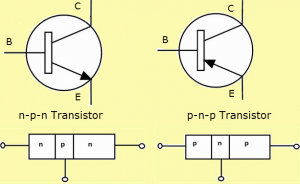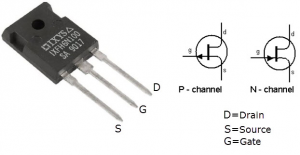Transistor is an active component and that is establishing in all over electronic circuits. They are used as amplifiers and switching apparatus. As the amplifiers, they are used in high and low level, frequency stages, oscillators, modulators, detectors and in any circuit need to perform a function. In digital circuits they are used as switches. There are a huge number of manufacturers approximately the world who produces semiconductors (transistors are members of this family of apparatus), so there are exactly thousands of different types. There are low, medium and high power transistors, for functioning with high and low frequencies, for functioning with very high current and or high voltages. This article gives an overview of what is a transistor, different types of transistors and its applications.
Different Types of Transistors
The transistor is an electronic equipment. It is made through p and n type semiconductor. When a semiconductor is placed in center between same type semiconductors the arrangement is called transistors. We can say that a transistor is the combination of two diodes it is a connected back to back. A transistor is a device that regulates current or voltage flow and acts as a button or gate for electronic signals. Transistors consist of three layers of a semiconductor device, each capable of moving a current. A semiconductor is a material such like that germanium and silicon that conducts electricity in a “semi-enthusiastic” way. It’s anywhere between a genuine conductor such as a copper and an insulator (similar to the plastic wrapped roughly wires).
Transistor Symbol
A diagrammatic form of n-p-n and p-n-p transistor is exposed. In circuit is a connection drawn form is used. The arrow symbol defined the emitter current. In the n-p-n connection we identify electrons flow into the emitter. This means that conservative current flows out of the emitter as an indicated by the outgoing arrow. Equally it can be seen that for p-n-p connection, the conservative current flows into the emitter as exposed by the inward arrow in the figure.

Transistor Symbols
There are so many types of transistors and they each vary in their characteristics and each has their possess advantages and disadvantages. Some types of transistors are used mostly for switching applications. Others can be used for both switching and amplification. Still other transistors are in a specialty group all of their own, such as phototransistors, which react to the amount of light shining on it to produce current flow through it. Below is a list of the different types of transistors; we will go over the characteristics that create them each up
Bipolar Junction Transistor (BJT)
Bipolar Junction Transistors are transistors which are built up of 3 regions, the base, the collector, and the emitter. Bipolar Junction transistors, different FET transistors, are current-controlled devices. A small current entering in the base region of the transistor causes a much larger current flow from the emitter to the collector region. Bipolar junction transistors come in two major types, NPN and PNP. A NPN transistor is one in which the majority current carrier are electrons. Electron flowing from the emitter to the collector forms the base of the majority of current flow through the transistor. The further types of charge, holes, are a minority. PNP transistors are the opposite. In PNP transistors, the majority current carrier is holes.

Bipolar Junction Transistor pins
Field Effect Transistor
Field Effect Transistors are made up of 3 regions, a gate, a source, and a drain. Different bipolar transistors, FETs are voltage-controlled devices. A voltage placed at the gate controls current flow from the source to the drain of the transistor. Field Effect transistors have very high input impedance, from several mega ohms (MΩ) of resistance to much, much larger values. This high input impedance causes them to have very little current run through them. (According to ohm’s law, current is inversely affected by the value of the impedance of the circuit. If the impedance is high, the current is very low.) So FETs both draw very little current from a circuit’s power source.

Field Effect Transistor
Thus, this is ideal because they don’t disturb the original circuit power elements to which they are connected to. They won’t cause the power source to be loaded down. The drawback of FETs is that they won’t provide the same amplification that could be gotten from bipolar transistors. Bipolar transistors are superior in the fact that they provide greater amplification, even though FETs are better in that they cause less loading, are cheaper, and easier to manufacture. Field Effect Transistors come in 2 main types: JFETs and MOSFETs. JFETs and MOSFETs are very similar but MOSFETs have an even higher input impedance values than JFETs. This causes even less loading in a circuit.











